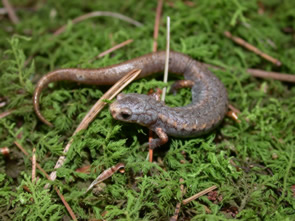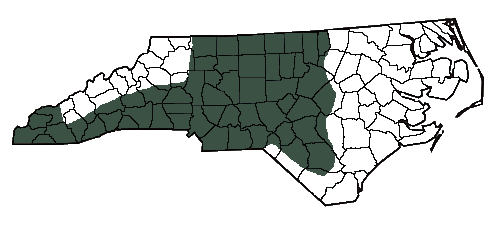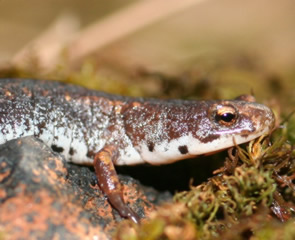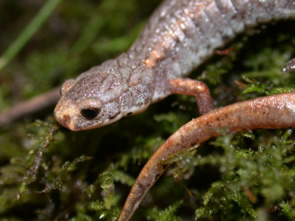
Four-toed Salamander
Hemidactylium scutatum
Hemidactylium scutatum
Photo by JD Willson
Listed: State Species of Special Concern.
Description: The four-toed salamander is a fairly small salamander with the unmistakeable combination of four toes on each rear foot, a constriction at the base of the tail, and a white belly with bold black spots. The back is mottled brown and the sides of the body are grayish with some light flecking. Larvae are slender and have prominent eyes, a dull yellowish back, and a dorsal fin that extends forward almost to the head.
Habitat/Range: Four-toed salamanders are found in much of central North Carolina but can also be found at a few locations in the mountains and the coastal plain. They generally live in forests surrounding swamps, bogs, marshes, and temporary bodies of water which are free of fish. In North Carolina, Four-toed salamanders spend much of their time underground and are not often encountered until they move to water during the breeding season.
Diet: Adult four-toed salamanders consume primarily small invertebrates. The larvae eat small, plankton-sized organisms as well as insects and other small invertebrates.
Reproduction: Mating occurs before females migrate from the woodlands to ponds, bogs, marshes, and streams to lay their eggs. Females seem to prefer laying their eggs in moss above water. Although some females may have solitary nests, many females lay joint nests to allow one of the females to leave. Upon hatching, the larvae make their way down to the water, where they spend about a month in an aquatic larval stage. After a month, the larvae transform into the adult body form and move into the forest. After about 2 years, these salamanders will be sexually mature.
Miscellaneous: Four-toed salamanders can expel noxious secretions to repel potential predators. If this fails, four-toed salamanders can voluntarily disconnect their tail. The broken tail wiggles and distracts predators, allowing the salamander to escape. Almost all other salamanders have tails that break off only when they are actually grasped by a predator.

The shaded region represents the range of the four-toed salamander in North Carolina.



Photo by JD Willson